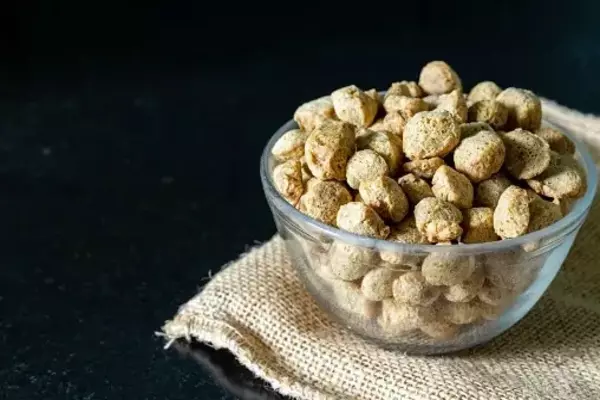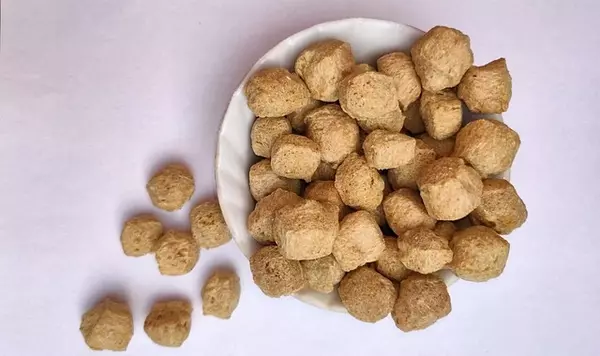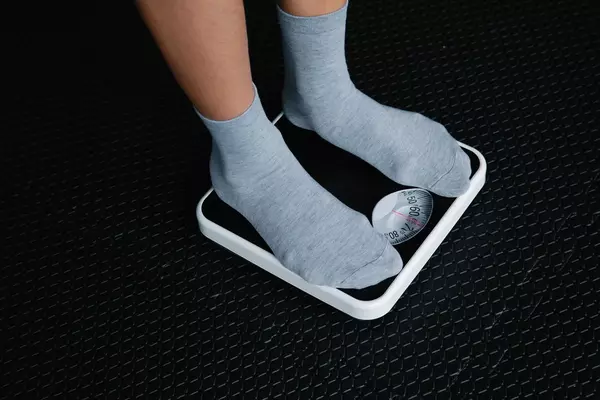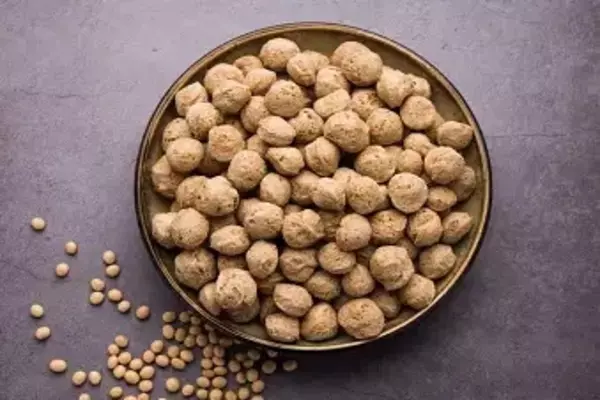Hello Friends, My name is Kirti Raj. I am a research scholar. Today, I will give you in-depth knowledge of Soya Chunks. I will tell you the benefits of soya chunks. Also, guide you on how to eat soya chunks for Weight loss? Let’s get started,
Soya chunks eventually replaced meat as a complement for everyone in this country. Vegetarians rely heavily on it due to its excellent nutritional profile.
Also read: Is Gumbo Good for Weight Loss?
Soya chunks are formed from soya flour that has removed the excess oil. Soya pieces are defatted in this manner. Soya pieces become dry in texture as the soybean oil is removed from them.
However, if soya chunks are cooked in any curry or gravy dish, they will imbibe the curry sauce and become juicy. That’s why they are occasionally referred to as vegetarian meat.
Non-vegetarians like it as a food alternative because of its nutritional benefits. It is also beneficial to your weight loss diet.
Table of Contents
Nutritional Value in Soya Chunks
Soya is high in polyunsaturated fats. It also provides rigidity and omega-3 fatty acids.
Also read: Is Caprese Salad Good for Weight Loss?
| Protein Content | 52 g |
| Carbohydrates | 33 gms |
| Dietary Fibre | 13 grams |
| Total Fat | 0.5 gram |
They are a calcium and iron storehouse free of sugar and sodium, making them safe for the body and helpful for your health.
Also read: Are Radishes Good for Weight Loss?

Soya is sometimes labeled as harmful to one’s health! Considering its nutritional levels and the qualities of the various primary nutrients, the nutritional levels it provides, and the qualities of the various primary nutrients, I nutritional levels it provides and the qualities of the various primary nutrients, I really shouldn’t think soya is all that horrible. Soya beans are healthy to eat daily for both men and women.
Are Soya Chunks Good for Weight Loss?
Soya chunks are a nutritious addition to your weight reduction diet. And here is how they can help you lose weight.
● Fiber content is high: Soya chunks contain a lot of fiber. Consuming fiber-rich foods digestion process keeps you fuller for longer. Fiber absorbs water and expands in both the stomach and intestine, maintaining you complete for an extended amount of time and eliminating regular food cravings. And also reduces overall calorie consumption and hence aids in weight loss.
Also read: Is Poha good for weight loss?
Furthermore, high-fiber foods take more time to swallow, giving your health more time to recognize when you are done and avoiding overloading. Because fiber delays processing, it also aids with blood sugar regulation.
● Full of Protein: High protein foods, such as soya chunks, offer substantial weight loss effects.
● Contains Good Fats: Good polyunsaturated fats are abundant in soya chunks. Polyunsaturated fats are high in vitamin E, a potent antioxidant with numerous health advantages.
They keep you from snacking and keep your calorie consumption under control. Natural fats are also necessary for increasing your metabolism. As a result, eating foods high in healthy fats, such as soy, can help you lose weight.
How to Eat Soya Chunks for Weight Loss?
Let’s go over how to make a basic soya chunk curry that can be served alone or with rice or Rotis.
Boil two and a half cups of water and soak one cup of soya chunks until tender.
Fry half a spoonful of jeera (cumin seeds) in one tablespoon of oil in a skillet.
Also read: Is Muenster cheese good for weight loss?
Fry two diced onions and two chopped green chillies till golden brown in the pan.
Mix in two teaspoons of garlic paste and two tablespoons of tomato paste.
Allow the entire mixture to simmer thoroughly. Then season with dhania (coriander) powder and salt to taste.
Lastly, add the soya chunks and simmer until thoroughly combined.
Other Benefits of Soya Chunks
● Soya chunks are high in protein, fiber, and omega-3 fatty acids while low in sodium and harmful fats. As a result, they are highly beneficial to heart health.
● As soya has a lot of fiber, it keeps you full for the last several hours after you eat it.
● Soya chunks are suitable for your intestines. It can increase the amount of bifidobacterial and lactobacilli in the stomach.

● It benefits intestinal health.
● A soy diet improves bone health and increases bone strength. As a result, it is a good source of vegan protein. It benefits your body even if you do not consume animal protein.
Also read: Are Banana and Oats Good For Weight Loss?
● Soya lowers the risk of heart disease. It also lowers the risk of developing malignancies, diabetes, and inflammatory illnesses.
Soya Chunks for Hair Growth
Fit and Stable Hair: Protein, the fundamental basis of hair, is abundant in soya chunks.
Protein content in soya chunks strengthens, improves texture, and repairs damaged hair. As a result, soy protein is commonly found in hair care products.
Soy chunk has several vitamins and nutrients, including folic acid, vitamin B, potassium, iron, and zinc, necessary for good hair growth. Its rich fat and low salt levels promote hair development as well.
Soya Chunks for Fatty Liver
Some data indicate that soy products, such as soy milk or tofu, may improve fatty liver. According to one study, research has demonstrated benefits in the metabolic effect of patients with NAFLD.
Eating soy protein in foods like tofu and yogurt reduces the load on fatty livers.
Moreover, the scientists found that soy protein isolates partially repaired the Wnt-catenin signaling pathway, essential in fat metabolism. Many obese persons have a traffic issue, and the liver is less strained when more fat can exit the organ.
Soya Chunks for Muscle Building
One thing that every boy is intrigued about from adolescence, besides a lot of other things, is well-built muscles. When they learn that idolizing is only one facet of muscle gain, they recognize that the important aspect is executing, attending a gym, and maintaining a decent diet that supports adequate recuperation.
Suppose there is anything that particular fitness enthusiasts are afraid of. In that case, it is soya chunks and their link to hormonal imbalance. For the hundredth time, we state that there is no specific link between ingesting soya chunks in limited quantities and increasing oestrogen in males.
Benefits of Soya Chunks for Acidity or Acid Reflux
Acid reflux arises when stomach acidic digestive juices escape into the oesophagus. It causes heartburn, a foul taste in the mouth, and a sore throat. Acid reflux can be remedied in various ways; however, soy milk can be a viable alternative for people whose distress is caused by cow’s milk. Acknowledging why soy and other plant-based glasses of milk may be superior may assist you in making decisions that alleviate your acid reflux symptoms.
Also read: How does Watermelon cause Belly Fat
If you suffer from acid reflux, you are undoubtedly aware that fatty foods will likely worsen your symptoms. The amount of fat in cow’s milk is one of the causes it may cause acid reflux. Fat slows digestion, causing undigested food to accumulate in the gastrointestinal tract. This strains the ring of muscle that seals the top of the stomach sealed, increasing the likelihood of reflux. One of the benefits of soy milk is that it has half the fat of whole milk.
Soya Chunks for Uric Acid
Soy’s association with health has steadily been a source of worry. The link involving soy and uric acid concentrations is debatable. Individuals with elevated serum or plasma uric acid levels are advised to avoid consuming soy because of the significant purine concentration of soy protein, which stimulates uric acid generation. However, the projected rise in daily intake among people of Asian heritage is almost clinically insignificant.
Soy eating had no influence on uric acid concentrations in humans. Whole soy and soy protein both elevated uric acid concentrations in the short term, according to studies on the acute and chronic effects of soy consumption on uric acid. On the other hand, soy products such as tofu, cake, and dried tofu showed no effect. Because it is rich in proteins, it is likely to elevate uric acid, and some studies have suggested that it includes goitrogens, which can affect thyroid functioning and cause goitre and hypothyroidism, particularly in women.
Soy Chunks for Allergy
Your immune system overreacts to soy proteins when you have a soy allergy. Symptoms include stomach discomfort, coughing, and itching. Anaphylaxis can result from a severe soy allergy. Soy allergies can be diagnosed by an allergist using testing. Medication and avoiding soy-containing items are part of the treatment.

Food allergies include soy allergies. Your immune system reacts inappropriately to soy consumption (eaten or drunk). For many people, consuming soy is risk-free. If you suffer from a soy allergy, your immune response perceives the protein in soy as a dangerous “invader,” similar to a bacteria or virus.
Any individual of any age can develop a soy allergy. However, newborns and young children are more likely to be allergic to soy. If you suffer from other food allergies, you are more prone to have a soy allergy.
As they grow older, many infants outgrow their soy allergy.
A soy intolerance causes your body to respond negatively. An allergic reaction occurs when your body reacts to an allergen. If you suffer from a soy allergy, your system may react in one of two ways:
- Immunoglobulin E-mediated reaction
- Non-immunoglobulin E-mediated reaction
Symptoms of soy allergies include:
- Stomach cramps
- Indigestion
- Nausea and vomiting
- Diarrhea
- Tightness in your throat
- Cough
- Itching
- Eczema
Soya Chunks for Constipation
Soya chunks are beneficial for a variety of reasons. They are a tasty and healthy meat substitute that can be employed in many dishes. This discussion reviews the top five reasons to include soya chunks in your diet.
They are high in protein and contain all the essential amino acids our bodies require. They’re also low in calories and fat, with no cholesterol. Furthermore, soya chunks are high in vitamins and minerals such as iron, calcium, phosphorus, and magnesium.
The significance of soy protein in constipation is being debated. Soy protein is being studied for its potential benefits to cardiorespiratory fitness, insulin resistance, carbohydrate, and lipid metabolism. Significant quantities of soy protein might induce or worsen constipation in some people. If you suffer from constipation, consult your doctor before adding soy protein supplements to your diet.
A low-fibre diet and dehydration are common causes of constipation. Taking soy protein over your body’s requirements might lead to dehydration. Soy’s high protein concentration makes complicated carbohydrate absorption harder. Because complex carbohydrates in a range of edible plants assist in relieving constipation symptoms, overeating soy protein puts you at risk for this disease.
The majority of constipation instances are not significant or long-lasting. Increasing your fibre intake to 25 g to 30 g daily may help relieve constipation. Fibre softens the faeces, allowing them to travel more swiftly through the colon. To receive the benefits of fibre, consume a lot of fluids, especially water.
Soya Chunks for Cholesterol
If you’re trying to lower your cholesterol, including tofu in your stir-fry, soy milk in your morning bowl of oatmeal, or edamame as a snack will help.
According to cardiologist James Beckerman, MD of Portland, OR, specific research suggests eating soy protein may benefit. However, the data is weak, so you should also make other dietary modifications to help your cholesterol.
Possibly. Although soy-based meals can marginally reduce your LDL (or “bad”) cholesterol level, the American Heart Association has found that soy does not significantly lower cholesterol.
However, soy-based foods can be advantageous because they contain less saturated fat than meat and include other nutrients such as good fats (monounsaturated fats), vitamins, minerals, and fibre.
If you replace animal-based items with soy, the substitution, rather than the soy itself, may lower your cholesterol.
See your doctor or a dietician if you want to add more soya to your diet.
Soya Chunks for Good Diabetes
Soya chunks are a by-product of the extraction of soybean oil. They are manufactured from leftover flour during oil extraction. Soya chunks are thus fat-free and prepared from oil-free, defatted flour. They are soft, fibrous, and spongy and are commonly referred to as “fake meat” since the chunks mimic meat in shape. They have a neutral flavour and hence combine well with various cuisines. Let us now examine its nutritional profile. Also, don’t be concerned about the calories in soya chunks.

Diabetes is a chronic disease with continually elevated blood glucose (sugar) levels. It can happen if your body cannot adequately make or use insulin (a hormone secreted by your pancreas that helps manage your blood sugar levels).
Diabetes cannot be cured but can be well managed with lifestyle modifications and drugs. Dietary adjustments are essential in maintaining appropriate blood sugar levels.
Including soya chunks in your diet has been shown to benefit diabetes. Soya chunks are high in isoflavones, which are beneficial chemicals. These substances reduce the chance of acquiring Type 2 Diabetes and aid in the prevention of blood sugar spikes.
Isoflavones operate by reducing insulin resistance and increasing insulin sensitivity in your cells. This allows the cells to absorb extra glucose from the blood and transform it into energy, decreasing blood sugar levels.
Soya Chunks Benefits for Skin
Having dull skin, wrinkles, and redness can be highly aggravating. We completely understand! When dealing with skin issues like these, you may be tempted to resort to the latest technologies and fads for solutions. Still, the best course of action is often to consider turning to natural products.
Soybeans, for example, benefit your overall health, and your skin garners many benefits. Soy skincare products foster a calm, even-toned, who-knew-skin-could-look-this-radiant complexion.
Soy has numerous beauty benefits, whether on your table or in a body cream! Here are six reasons why you should adore this incredible ingredient.
● Improves the texture of your skin
Soy includes antioxidant molecules called isoflavones, which may help to reduce the appearance of skin aging. So, including soy-rich foods like tofu and soy milk in your diet might help reduce symptoms of dullness and wrinkles, giving you a smoother, more youthful appearance. It may also boost collagen production in the skin.
● Skin appears bright and radiant
These antioxidant chemicals are powerful skin brighteners, creating a radiant and even-toned appearance. Presenting soy skincare products is a great way to take use of soy’s brightening characteristics.
● Defends against hyperpigmentation
When soy is added to the mix, hyperpigmentation, which appears as regions of darker skin, tends to improve significantly. Soy works by preventing melanin from accumulating in the uppermost layer of the skin, hence preventing uneven skin tone. Finest of all, soy skincare products are often suitable for all skin types, including the most sensitive.
● Redness is reduced
Yes, soy reduces the appearance of black spots and discolouration. Still, it also can reduce skin redness, making it great for people suffering from rosacea or inflammation. Soy provides a relaxing sensation that relaxes the skin, and it’s an excellent choice for addressing lines and wrinkles without risking irritation caused by stronger chemical compounds.
● Reduces solar damage
The summer sun is a wonderful experience, but the dark spots, discolouration, and accelerated aging that it can produce are not. You already know that wearing sunscreen all year is the most effective approach to protecting your skin from UV damage. Nevertheless, you’re only human if you forget to apply sunscreen occasionally! Maybe more frequently. Fortunately, soy can save the day once more!
● Firms and plumpifiesaging skin
Hormonal fluctuations might appear to drain the life right out of the skin, which no one wants. Oestrogen keeps skin firm, so when your hormone levels fluctuate, your skin suffers. Fortunately, research indicates that soy can have estrogenic or anti-estrogenic activity.
Benefits of Soya Chunks for Thyroid
Soy foods are a longstanding component of Asian diets. Still, due to their alleged health benefits, they have gained popularity recently among non-Asian consumers, particularly postmenopausal women. Numerous bioactive soybean components may contribute to the theorized health advantages of soy. Still, the isoflavones, which have both hormonal and nonhormonal properties, have received the most attention. Despite the potential benefits, some people have voiced concern that soy may harm certain groups of people. One issue is that soy may impair thyroid function and impede synthetic thyroid hormone uptake.
The aim of this review is to analyse the pertinent data and provide doctors with guidelines for discussing the effects of soy on thyroid function with their patients. There were a total of 14 trials that looked at how soy diets or isoflavones affected at least one measure of thyroid function in presumably healthy individuals. Of these trials, eight exclusively involved women, four involved men, and two involved both men and women. With one exception, no effects or very minor changes were observed in these experiments. As a result, the data show a minimal indication that soy diets or isoflavones have a harmful effect on thyroid function in euthyroid, iodine-replete people. In contrast, some evidence suggests that soy meals may raise the dose of thyroid medication by slowing absorption.
Soya Chunks Side Effects
Though including soya chunks in your regular diet is healthy in many ways, overconsumption might lead to issues like as;

Stomach Issues
Excessive consumption of soya chunks might result in stomach problems such as constipation, gas, soreness, and flatulence. As a result, always remember to consume them in moderation.
Kidney Stones
Excessive soya eating can increase the chance of forming kidney stones. Soya chunks are high in uric acid, and high uric acid levels in the body can lead to kidney stone production. As a result, remember not to consume more than the suggested amount of soya chunks each day.
Failure of the kidneys
Phytoestrogens are abundant in soya chunks. If eaten in excess, these chemical substances might cause kidney injury.
Conclusion
Soya chunks are delicious and simple to prepare. They also provide a myriad of health advantages. As a result, some of these include weight loss, enhanced bones and teeth, improved health, and much more!
However, some of the adverse effects must be remembered. These include gastric problems, kidney failure, and so on.
Moderation is the key here, as it is with other foods. Several dieticians recommend consuming 25 to 30 grams of this healthful food daily. This amount of soya in your diet will not cause an increase in hazardous oestrogen levels. This amount will also not raise the level of uric acid in your body.
Many doctors believe that the home-cooked version of these chunks is always preferable. This will allow you to absorb the most nutrients and gain the most benefits. The home-cooked version is not harmful and provides all the health benefits.
I hope you get in-depth information on soya chunks, like their nutritional value, benefits, and How to eat them for weight loss? If you want any other information about soya chunks, Please mention your question in the Comment Box of Fizyfit. I will be pleased to help you out.
Frequently Asked Questions
Q1: How are soya chunks made?
Ans: Soya chunks are made from defatted soy flour drained of its oil. They are by-products of soybean oil extraction and have a gritty feel when dry. The texture instantly transforms into soft and spongy when soaked in warm water or added to the gravy.
Q2: Is it okay to consume 100gm soya chunks a day?
Ans: However, excessive consumption of soy chunks should be avoided. The presence of phytoestrogens may occasionally be harmful. It may result in health issues such as hormone imbalance, thyroid imbalance, and increased uric acid levels. The daily suggested serving of soy chunks is 15- 25 grams.
Q3: Are soya chunks a good source of protein?
Ans: Soya chunks are well-known for their numerous health advantages. It has a high protein level, surpassing eggs, meat, and milk. It is believed to lessen the risk of osteoporosis in menopausal women and to alleviate other symptoms due to its high isoflavone content.
Q4: Best time to eat soya chunks?
Ans: Compared to chicken breast richness, soya chunks can provide high protein levels before a workout. Because they are a defatted variety of soya beans, they are the most spongy and healthier.
Q5: Are soya chunks complete protein?
Ans: Unlike other plant and other vegetarian sources, soya provides a complete source of dietary protein. As a result, soya includes all of the essential amino acids.
Q6: Are soya chunks non-veg?
Ans: Soya chunks, granules, and nuggets are made from soya, a natural source of plant-based protein.
Q7: What is the difference between soybean and soya chunks?
Ans: Soya chunks are made from defatted soy flour drained of its oil. They are by-products of soybean oil extraction and have a gritty feel when dry. When soaked in warm water or put to gravy, the texture instantly transforms into soft and spongy.
Q8: What happens if we eat soya chunks daily?
Ans: Although soya chunks have a high nutritional value, excessive ingestion might result in elevated uric acid and oestrogen levels in your body. The consequences are weight gain, acne, bloating, mood changes, liver damage, water retention, and joint discomfort.
